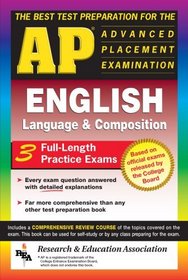Search -
AP English Language & Composition : The Best Test Preparation for the Advanced Placement Examination
AP English Language Composition The Best Test Preparation for the Advanced Placement Examination
Author:
Get the AP college credits you've worked so hard for... Our savvy test experts show you the way to master the test and score higher. This new and fully expanded edition examines all AP English Language & Composition areas including in-depth coverage of critical writing and critical reading. The comprehensive review covers every possible exam top... more »
Author:
Get the AP college credits you've worked so hard for... Our savvy test experts show you the way to master the test and score higher. This new and fully expanded edition examines all AP English Language & Composition areas including in-depth coverage of critical writing and critical reading. The comprehensive review covers every possible exam top... more »
ISBN-13: 9780878919239
ISBN-10: 0878919236
Publication Date: 1/13/1994
Pages: 272
Rating: 1
ISBN-10: 0878919236
Publication Date: 1/13/1994
Pages: 272
Rating: 1
0.5 stars, based on 1 rating
Publisher: Research & Education Association
Book Type: Paperback
Members Wishing: 1
Reviews: Amazon | Write a Review
Book Type: Paperback
Members Wishing: 1
Reviews: Amazon | Write a Review
Genres:
- Reference >> Education >> Study Guides
- Reference >> Education >> College & High School >> Advanced Placement
- Reference >> Test Prep Central >> General
- Reference >> Words, Language & Grammar >> General
- Reference >> Words, Language & Grammar >> Grammar
- Reference >> Words, Language & Grammar >> Rhetoric




